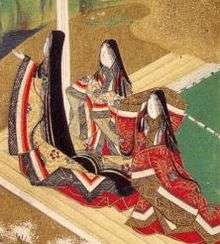Kyahan
Kyahan (脚絆(きゃはん)) are cloth leggings worn by the samurai class and their retainers in feudal Japan.[1] In Japanese the word is also used for western soldier's gaiters.
Description
Kyahan were worn as padding underneath the samurai greaves (suneate). Some types of kyahan could be covered with mail armour (kusari kyahan or kyahan suneate), these were worn by foot soldiers ashigaru or by samurai as protection.[2] Kyahan were worn by ordinary travelers as protection from cold, insects and underbrush.[3] Kyahan are often made of linen, but other materials such as cotton can be employed. Kyahan components depend on the season. When tying kyahan, the inner cords are shorter than the outer ones; it is also advisable that the cords are tied on the inner side of the legs instead of on the front or outer area. This helps prevent discomfort when the stiff greaves are placed over the kyahan.
See also
| Wikimedia Commons has media related to Kyahan (kiahan). |
References
- ↑ Arms and armor of the samurai: the history of weaponry in ancient Japan, Ian Bottomley, Anthony Hopson, Crescent Books, 1993, 2008 ISBN 0-517-10318-4, ISBN 978-0-517-10318-0 Pgs 30, 80, 185
- ↑ Secrets of the samurai: a survey of the martial arts of feudal Japan, Oscar Ratti, Adele Westbrook, Publisher Tuttle Publishing, 1991, ISBN 0-8048-1684-0, ISBN 978-0-8048-1684-7 P. 199
- ↑ A handbook for travellers in Japan, John Murray , Basil Hall Chamberlain, W. B. Mason, Publisher J. Murray, 1894, Original from the University of California, Digitized Nov 21, 2007 P.9
Sources
- Turnbull, Stephen (1998). The Samurai Sourcebook. London: Arms & Armour Press. ISBN 1-85409-371-1 [reprinted by Cassell & Co., London, 2000. ISBN 1-85409-523-4 ]
